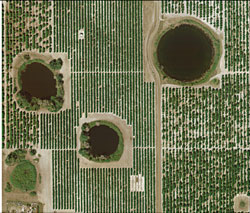This release can be found in the USGS Newsroom at: http://www.usgs.gov/newsroom/article.asp?ID=2236.

News Release | |||||
|
Pesticides Found in Central Florida Lakes
Pesticide-related compounds and elevated levels of nitrate have been found in lakes in central Florida’s Lake Wales Ridge region. The compounds found include currently used pesticides, according to the recently published U.S. Geological Survey (USGS) report. The concentrations of some of these compounds were among the highest in surface-water samples when compared to a previous study of agricultural areas around the nation.
“These findings support previous studies in this region that indicate a high potential for chemicals applied on the land to be carried with the water through sandy soils,” said Anne Choquette, USGS scientist and lead author of the study. “Our samples show that currently used chemicals are only partially broken down by the time the groundwater enters the lakes.”

|
| Satellite view of Swim Lake (upper right) and nearby lakes in Polk County, Florida, surrounded by citrus groves. Courtesy Florida State University, 2008; Southwest Florida Water Management District, 2008. |
“This area is a major citrus producer for Florida and for the nation. The long-growing season means that pesticides are applied multiple times per year,” said Choquette. “When you combine that with a wet climate, soils lacking in organic materials to help filter or break down substances, and porous drinking-water aquifers, you have a water system that must be watched closely,” said Choquette. “Early detection of chemicals is important in this region and we have helped state agencies to develop a sampling network to detect contaminants as they enter the shallow sand aquifers.”
Lakes in the area are not used for public drinking water. None of the samples exceeded federal or state drinking-water benchmarks for nitrate or pesticide concentrations. Aquatic-life benchmarks exist for ten of the 20 pesticide compounds found and no concentrations met or exceeded those benchmarks. Yet questions remain about the possible impacts of these substances. Benchmarks for some of these chemicals and for chemical mixtures are still in the process of development.
For this study, scientists tested eight lakes for 83 pesticides and related chemical compounds. Seven of the lakes are surrounded predominantly by citrus groves which were compared with one lake surrounded by relatively undeveloped land. In the seven lakes located in citrus areas, nine to 14 compounds were detected per lake, compared with three compounds detected at very low levels from the lake in an undeveloped area.
The Florida Department of Environmental Protection (FDEP), the Southwest Florida Water Management District (SWFWMD), and the USGS conducted this study as a ‘regional reconnaissance’ to look at what happens to currently-used pesticides and their break-down products known as ‘degradates’, after they are applied to the land surface. The compounds most frequently found include norflurazon and its degradate, bromacil, simazine degradates, diuron and its degradate, aldicarb degradates, metalaxyl, and 2,4-D. The lakes in citrus areas also were enriched with chemicals used as citrus fertilizers.
The common occurrence of pesticide mixtures in the lakes means that the combined toxicity may be greater than that of any single pesticide compound. Some of these pesticides have also been found in urban and residential areas in surface waters, indicating sources are not limited to just agriculture. Because decades-long studies are difficult to conduct, the impact of chronic exposure to these mixtures is unknown.
More than 200 lakes occur in the Lake Wales Ridge, located in Florida’s Polk and Highland counties. Many of the region’s lakes are ‘flow-through’ lakes, meaning that water seeps in and out of the lakes and is connected with water found in aquifers near the surface. Water from the lakes can also flow into deeper groundwater systems such as the Upper Floridan aquifer, which is the region’s principal drinking-water source. This makes it critical to understand what happens to pesticides that are currently being used in the region. Atmospheric transport via wind and rainfall was not measured directly but could be an additional way that chemicals move into the lakes.
In the study, scientists also tested their ability to make regional predictions about which pesticides were at highest risk of occurring in the lakes. They calculated ‘risk’ indexes by combining Florida’s pesticide-use estimates with known properties of pesticide break-down in water. There were differences between what was expected and what was actually observed. That means scientists still need to rely on water quality-sampling to accurately assess pesticide occurrence in the lakes.
“Some of the differences between the predictions and our results may be due in part to differences between local pesticide use and the statewide averages, but it appears we may also have more to learn about how the chemical breakdown of pesticides occurs within different environmental settings,” added Choquette.
This study is unique in that very few studies have looked for pesticides in small to medium-sized lakes, or tested as many pesticide break-down products. Since the water resources in the area are so interconnected, this kind of information helps scientists understand where these chemicals go, how they break down and if they are posing threats to our water resources.
USGS provides science for a changing world. For more information, visit www.usgs.gov.
Subscribe to USGS News Releases via our electronic mailing list or RSS feed.
**** www.usgs.gov ****
Links and contacts within this release are valid at the time of publication.
Diane
Noserale
Media Relations, Eastern Region
U.S. Geological Survey
150 National Center
Reston, VA 20192
phone: 703-648-4333
fax: 703-648-4588
